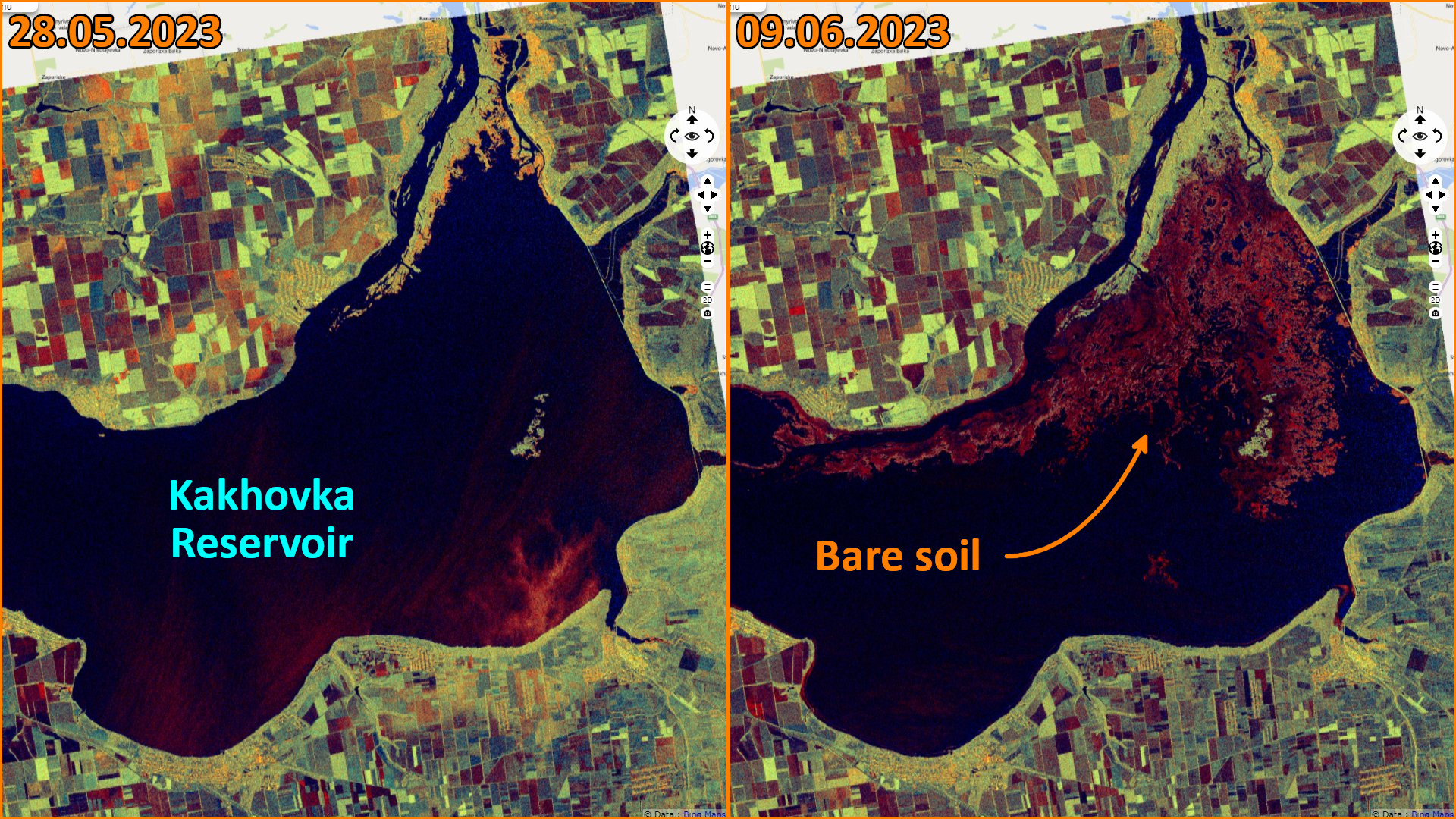Consequences of the destruction of Kakhovka dam, Ukraine
Sentinel-3 OLCI FR acquired on 01 June 2023 at 07:58:33 UTC
Sentinel-3 SRAL LAND acquired on 08 June 2023 at 08:06:26 & 18:57:57 UTC
Sentinel-2 MSI acquired on 08 June 2023 at 08:46:01 UTC
...
Sentinel-1 CSAR IW acquired on 09 June 2023 at 15:36:57 UTC
Sentinel-3 SRAL LAND acquired on 08 June 2023 at 08:06:26 & 18:57:57 UTC
Sentinel-2 MSI acquired on 08 June 2023 at 08:46:01 UTC
...
Sentinel-1 CSAR IW acquired on 09 June 2023 at 15:36:57 UTC
Keyword(s): Emergency, flooding, infrastructure, lake reservoir, hydropower, food security, energy security, agriculture, fishing, biodiversity, pollution, Ukraine
The Kakhovka Dam in Ukraine was destroyed in the early hours of 6 June 2023, causing extensive flooding along the lower Dnieper river in Kherson Oblast. The dam was under the control of the Russian military, which had seized it in the early days of the Russian invasion of Ukraine.
Dinara Khalilova gave a provisional human and material toll on The Kyiv Independent: "According to the Interior Ministry, 2743 residents of Kherson Oblast have been evacuated, including 205 children and 76 people with reduced mobility. In Mykolaiv Oblast, 31 settlements have been flooded, from which 982 people, including 167 children, have been rescued, the ministry wrote on Telegram. "Ten people died, and 42 are considered missing, including seven children, Interior Minister Ihor Klymenko reported on June 12."
"At the very least, it has forced the evacuation of thousands of people, flooded national parks and jeopardised water supplies to millions of people. In the worst-case scenario, it may pose a long-term danger to Europe’s biggest nuclear plant, Zaporizhzhia, and could also spread agrotoxins and petrochemicals into the Black Sea.", wrote Jonathan Watts for the Guardian
"Ukrainian scientists are waiting for the water to subside before fully assessing the environmental impact of the Kakhovka dam breach, but one former minister warned it could prove the country’s worst ecological disaster since the Chornobyl nuclear meltdown."
"The destruction of the Kakhovka dam will flood tens of thousands of hectares of agricultural land in southern Ukraine and could turn at least 500 000 hectares of land left without irrigation into 'deserts', the agriculture ministry said." according to Reuters. Globally, the effect will be felt far from the war as grain price have inflated as a response to the destruction.
"Floodwater has inundated tens of thousands of hectares of farms and arable lands, washing away their topsoil layers, according to Ukraine’s environment ministry. 'We will not be able to cultivate agricultural plants on this soil for many years ahead,' said Krasnolutskyi. The floods could wash fertilizers used on agricultural land into the river, where they could disrupt aquatic ecosystems."
The Ukrainian Ministry of Agriculture estimated a loss of $285M USD to the fishing industry, as a result of fish being stranded in shallows as the water level goes down or carried to flooded land where they will die after the flood recedes, as well as freshwater fish being exposed to saltwater and vice versa.
The reservoir has a total capacity of 18 km3. Its level was quickly increasing before the dam destruction, water levels in the reservoir had reached a 30-year high by late May. The dam used to generate 1.4 TWh yearly which is enough to power 350 000 typical European homes. In addition, it provided large quantity of water to cool Zaporizhzhia nuclear power plant which may not be restarted until its water input is secured, further hampering energy production of Ukraine.
The structure was too robust to de destroyed by a missile or a conventional bomb according to experts, it is thought tons of explosives could have been detonated from within the dam structure.
Isabel Van Brugen provides additional hint on the US magazine Newsweek: "On May 30, a week before the dam's collapse, the Russian government approved a law aimed at 'ensuring the safety of hydraulic structures' in the Ukrainian regions it proclaimed to have annexed in September 2022—the Donetsk and Luhansk regions, in Kherson, and Zaporizhzhia.
The legislation states that until January 1, 2028, investigations into accidents at hydro-technical structures that occurred as a result of military operations, sabotage and terrorist activities are prohibited. The decree was signed by Russian Prime Minister Mikhail Mishustin and came into effect on the day it was published."











